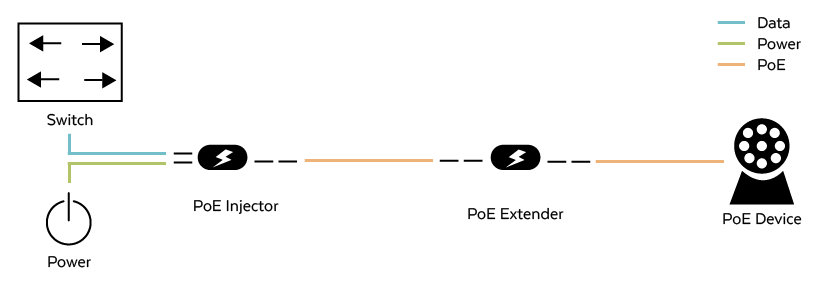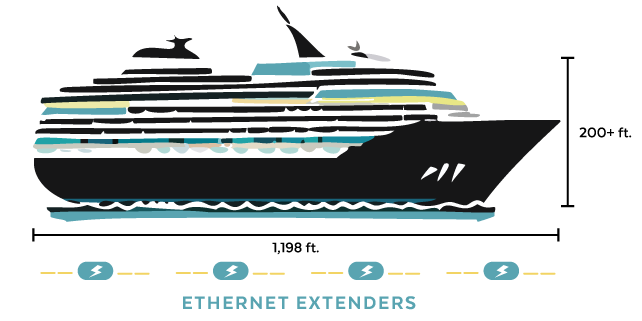Ethernet networks have evolved from connecting a few workstations in the same building to lighting up entire corporate campuses. Companies have embraced the Internet of Things (IoT), placing smart devices in warehouses, labs, and office buildings to monitor assets and save energy. While expanding networks may provide organizations with better operational controls, expansions can be challenging for network professionals who must find ways to stretch Ethernet networks to devices operating at the edge. Ethernet cables have a maximum deployment length of 328 feet. Going beyond the recommended length can cause a drop in voltage from DC 48V at the injection point to DC 39V at 100 meters. Distance can cause signal degradation, increase latency, and reduce transmission speeds. Ethernet extenders can increase cable length without performance or power loss. However, extenders often require an external power source. PoE extenders eliminate the need for external power sources. Ethernet and PoE extenders can provide a cost-effective solution for businesses looking to grow their network.
What is a Network Extender?
Extenders are any device that increases a network’s range. WiFi extenders improve wireless network connectivity. Extenders can also increase the length of an Ethernet connection beyond the standard 328 feet.
Ethernet Extenders
Ethernet extenders provide long-distance connectivity over UTP, coaxial, and phone wires. Their compatibility with existing network cabling allows organizations to increase their network range to over 2,000 meters without installing additional fiber optic cables or relying on wireless connections.
PoE Extenders
PoE extenders function similarly to Ethernet extenders, except they do not require an external power source. PoE technology allows an Ethernet cable to transport power and data over a single connection, allowing companies to extend their network without additional electrical wiring.
How Does a PoE Extender Work?
Suppose a construction company wants to increase its exterior surveillance system to prevent theft. Power does not exist beyond the original surveillance area. Installing a PoE extender between the switch and cameras allows the company to move beyond the 100-meter limitation.
A 328-foot Ethernet cable would connect the PoE extender to a switch, and a second cable would connect the extender to the device (camera). This configuration doubles the Ethernet run. Some PoE extenders allow daisy chaining to extend the reach even further.
How Are Ethernet Extenders Used?
Ethernet technology has many applications, from security cameras and surveillance systems to smart buildings and offices. It plays a crucial support role in transportation systems and healthcare facilities. Here are a few lesser-known use cases for Ethernet and PoE extenders that showcase the potential of this technology.
Cruise Ships
Most cruise lines offer internet access to their guests, but this addition can serve other purposes as well. Creating an on-ship network allows centralized management of lights, temperature, and cameras. Sensors deployed throughout the ship make monitoring critical systems easier.
The largest cruise ship (Icon of the Seas) is 1,198 feet long with 20 decks and 2,805 staterooms. These floating cities can be nearly 250 feet wide and loom over 200 feet above the water line. They are larger than a military aircraft carrier and many office buildings. Without extenders, these vessels could not ensure reliable operations while at sea.
Smart Factories
Building smart factories requires merging old and new technology. It means stretching existing capabilities to deliver the data necessary to improve operations and increase efficiency. Ethernet extenders can help expand existing networks, reducing the need for rewiring.
PoE extenders can provide power to remote devices while stretching network perimeters. They can serve as a bridge that allows old and new infrastructures to coexist seamlessly. Instead of paying for widespread replacement, Ethernet extenders enable manufacturers to capitalize on their initial investments.
Temperature Kiosks
The contactless temperature scanning market is expected to grow 10.4% between 2021 and 2031. During the COVID-19 pandemic, many handheld scanners were replaced with kiosks that provided patients and staff in healthcare facilities with contactless temperature readings. After using their identification badges to activate the scanner, staff would step in front of the kiosk for a temperature reading.
Placing temperature kiosks at staff entry points can be challenging. Networks may not extend to staffing areas. Ethernet and PoE extenders can tie the kiosks to the network without extensive wiring. If kiosks can’t be placed near power outlets, PoE extenders can provide the 20W of power that many kiosks require. Extenders help ensure a healthy workplace without adding to staffing requirements.
Choosing the Right Ethernet Extender
Selecting the best extender means understanding your network requirements. Organizations need to consider existing and future needs when evaluating an Ethernet extender. They should consider the following factors when choosing an Ethernet extender:
- Cables: Network extenders are designed for existing networks that use coaxial cables or UTP wiring. Some extenders may only support a single connection type, so be sure the extender you choose is compatible with existing connections.
- Bandwidth: How fast does data need to be transmitted? Speed may not be a concern if data uploads from a remote device. However, monitoring devices may need a faster connection to ensure alerts are addressed in real-time.
- Distances: Always check your coverage distance. Will a single extender be sufficient, or will daisy-chaining be required?
- Power: Is power available near the extender? If not, PoE extenders can provide the power necessary to operate without requiring an external power source.
- Switch: Some extenders may include switch capabilities. If a combination extender is needed, decide on the type of switch. Does a self-managed switch work best with your network, or would unmanaged suffice?
- Ports: Determine how many devices will be connected. Purchase an extender that has sufficient ports for current and future needs.
- Environment: Will the extender be operating in extreme environments? Will it be exposed to the elements? Hardened or industrial extenders are available for use outdoors or in harsh environments.
Be sure to consider worst-case scenarios. How will the network configuration work if there is a power failure? Are devices protected against power surges? If the extenders are installed in critical operational areas, what plans are in place to ensure continuous operation?
Ethernet extenders can provide a cost-effective solution to maximize existing infrastructure as your network grows. Planet Technology’s LRE-104 extender offers long-distance Ethernet over four UTP RJ45 ports and one UTP RJ45 BCN connector. The device is housed in a metal casing for added protection. Contact us today for help finding the right extender for your needs.



